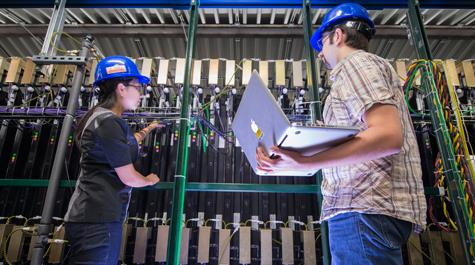NOvA, the largest particle-accelerator neutrino experiment in the United States, released some of its first results in early August. Managed by the Department of Energy’s Fermilab, the NOvA experiment involves hundreds of academics across the nation, including several professors and graduate students from the College of William and Mary.
Neutrinos are a fundamental particle; physicists believe neutrinos cannot be broken down into smaller particles. Radioactive decay, the sun and the Big Bang all are responsible for producing neutrinos. These particles come in three ‘flavors’ depending on the origin of the particle: muon neutrino, tau neutrino and electron neutrino. In the last 20 years, physicists have found neutrinos that transition between ‘flavors’ as they move through space.
The NOvA experiment uses the particle accelerator at Fermilab, located in Batavia, Illinois, to send a pulse of neutrinos through the Earth’s crust to the Far Detector, 500 miles away. The Far Detector is located in NOvA’s lab in Ash River, Minnesota, where a large plastic structure filled with scintillator, a clear liquid that lights up when a particle passes through it, allows scientists to detect the rare interactions of neutrinos with other particles.
“This transition, or oscillation as we call it, can only happen if the neutrino has mass,” associate physics professor Patricia Vahle said in an email. “The mass is small; in fact it is too small for us to have measured it directly yet, but we know it can’t be zero.”
Associate professor of physics Jeffrey Nelson and Vahle have been leading the College’s involvement in the NOvA experiment.
“I was involved in building the prototype detector for the experiment … [helping] commission the real detectors while I was on sabbatical at FNAL [Fermi National Accelerator Laboratory], and most recently, I was the leader of the working group charged with doing our primary analysis, the search for electron neutrinos in our Far Detector,” Professor Vahle said. “In this role, I coordinated the efforts of a group of [about] 10 grad students and postdocs from different universities across the US.”
Nelson has been involved with the NOvA experiment during the planning stages for over ten years. Even with the help of hundreds of undergraduate students, the Far Detector took more than five years to build and began experiments less than a year ago according to the Fermilab website.
“We have been able to involve a number of students in the installation and commissioning of the experiment and in collecting and analyzing the data, both undergraduates and graduate students,” Nelson said in an email.
According to William and Mary News, Nelson and Vahle, along with associate professor Michael Kordosky, just received the first installment of a three-year $1.4 million grant from the National Science Foundation to continue their work on the NOvA experiment and other neutrino research.
Additionally, there are several graduate students at the College involved in the experiment. Ji Liu Ph.D. ’15 is writing her thesis on the electron neutrino analysis from the NOvA experiment under Professor Vahle.
According to Liu, the NOvA experiment is significant because of the many unanswered questions about neutrinos.
“Compared to other physics subjects, it’s a very new subject,” Liu said. “We discovered the information about neutrinos in about 2000. That’s how young it is, so there are a lot of theories and a lot of unanswered questions.”
Neutrinos are also some of the most difficult particles to study, and have been dubbed the ‘ghost particle.’ They interact very little with matter, thus making them difficult to detect. They can pass through matter without leaving a trace. Neutrinos are many millions of times smaller than the next largest particle and have no charge. Due to all these factors, the process to locate neutrinos requires several components.
“You need a lot of neutrinos, very big detectors, and you have to take data for a long period of time, just to observe a handful of neutrino interactions,” Vahle said.
According to Vahle, most of the processes that shaped the early universe should have created equal amounts of matter and antimatter. The antimatter and matter should have annihilated each other, leaving only energy, but the universe we know today looks much different. Neutrinos could hold the key to understanding why this is, through differences in the oscillation of neutrinos and antineutrinos.

